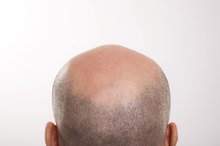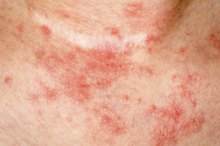Disease and Hair Styles Can Be The Culprit
If you notice that your hair is thinning and the scalp underneath is pink, this can indicate inflammation or a scalp disease, such as scalp psoriasis or dermatitis. Traction alopecia can also cause a pink scalp. Traction alopecia occurs when you have consistently pulled your hair into a style that causes it to break, such as weaving or a tight bun. Increased sebum (oil) production can result when you are routinely styling your hair in a manner that is pulling on it or prolonging pressure. The increased sebum can cause thinning hair as well as an inflamed scalp.
- If you notice that your hair is thinning and the scalp underneath is pink, this can indicate inflammation or a scalp disease, such as scalp psoriasis or dermatitis.
- Traction alopecia occurs when you have consistently pulled your hair into a style that causes it to break, such as weaving or a tight bun.
Other Possibilities
Ringworm can cause a pink scalp. Autoimmune diseases such as lupus can result in a pink scalp along with thinning hair. If you pull on your own hair, which is called trichotlillomania, this can result in an irritated scalp that turns pink, as well as loss of hair, according to Hairenergizer.com.
Back Off On The Bleach
Scalp Conditions That Cause Hair Loss
Learn More
If you are overly processing it, this can cause your scalp to turn pink. Your scalp may be having an allergic reaction to the chemicals that have been used on your hair. The scalp may actually turn red. Chemical treatments can cause hair thinning and loss.
- If you are overly processing it, this can cause your scalp to turn pink.
Psoriasis
The Mayo Clinic notes that plague psoriasis can occur in the scalp and it tends to be chronic. This is the most common form of psoriasis. Your scalp will turn red or pink and be covered with silvery scales. The areas that are affected will be oval or circular. Another kind of psoriasis is specifically called scalp psoriasis, which results in heavily crusted plaque areas and dry, scaly skin. The plaque can peel or flake off in crusty clumps.
- The Mayo Clinic notes that plague psoriasis can occur in the scalp and it tends to be chronic.
- Another kind of psoriasis is specifically called scalp psoriasis, which results in heavily crusted plaque areas and dry, scaly skin.
Actinic Keratosis
Can Vaseline Be Used for Dry Scalp?
Learn More
If your scalp has been overly exposed to the sun, you may be experiencing actinic keratoses, according to Mayo Clinic Health Horizons writing for Blue Cross and Blue Shield of Rhode Island. A lesion or lesions will form on your scalp and your scalp may turn pink. When actinic keratosis occurs, it happens in the top layer of your skin, which is the epidermis. When your skin cells are damaged from sun exposure, the color and texture of your skin, including your scalp, will change and lesions, bumps and blotches can occur.
- If your scalp has been overly exposed to the sun, you may be experiencing actinic keratoses, according to Mayo Clinic Health Horizons writing for Blue Cross and Blue Shield of Rhode Island.
- When your skin cells are damaged from sun exposure, the color and texture of your skin, including your scalp, will change and lesions, bumps and blotches can occur.
Seek Help
Ask your hairdresser or your physician what type of anti-bacterial shampoo she would recommend. This will get rid of bacteria, if that’s what is causing your pink scalp, while also protecting and moisturizing your hair. A shampoo of this nature will deeply penetrate into your scalp.
Related Articles
References
- Ranganathan S, Mukhopadhyay T. Dandruff: the most commercially exploited skin disease. Indian J Dermatol. 2010;55(2):130-4. doi:10.4103/0019-5154.62734
- Gavazzoni dias MF. Hair cosmetics: an overview. Int J Trichology. 2015;7(1):2-15. doi:10.4103/0974-7753.153450
- Datta HS, Mitra SK, Paramesh R, Patwardhan B. Theories and management of aging: modern and ayurveda perspectives. Evid Based Complement Alternat Med. 2011;2011:528527. doi:10.1093/ecam/nep005
- Carson CF, Hammer KA, Riley TV. Melaleuca alternifolia (Tea Tree) oil: a review of antimicrobial and other medicinal properties. Clin Microbiol Rev. 2006;19(1):50-62. doi:10.1128/CMR.19.1.50-62.2006
- Satchell AC, Saurajen A, Bell C, Barnetson RS. Treatment of dandruff with 5% tea tree oil shampoo. J Am Acad Dermatol. 2002;47(6):852-5. doi:10.1067/mjd.2002.122734
- Huang TH, Wang PW, Yang SC, Chou WL, Fang JY. Cosmetic and therapeutic applications of fish oil's fatty acids on the skin. Mar Drugs. 2018;16(8). doi:10.3390/md16080256
- Piccardi N1, Manissier P. "Nutrition and nutritional supplementation: Impact on skin health and beauty." Dermatoendocrinol. 2009 Sep;1(5):271-4.
Writer Bio
Cindi Pearce is a graduate of Ohio University, where she received her bachelor’s degree in journalism. She completed both the undergraduate and graduate courses offered by the Institute of Children’s Literature. Pearce has been writing professionally for over 30 years.









